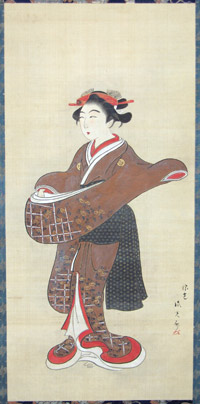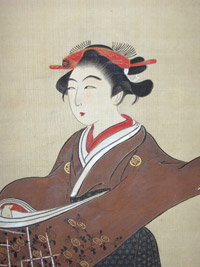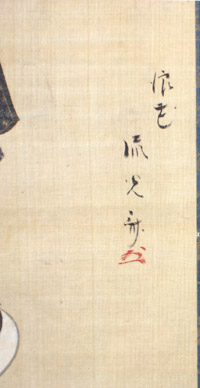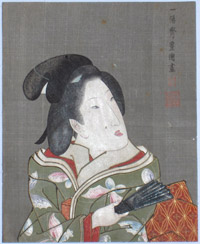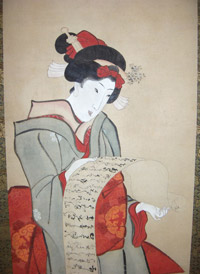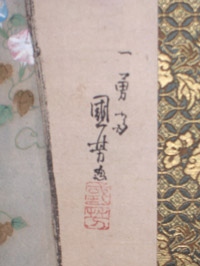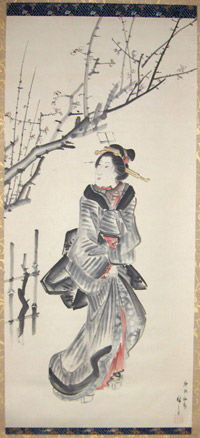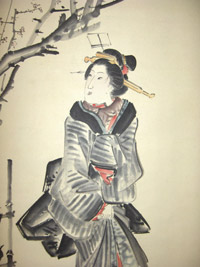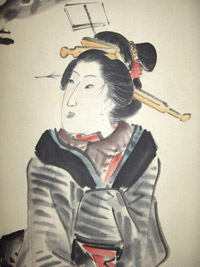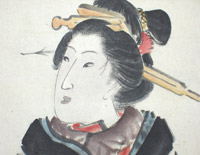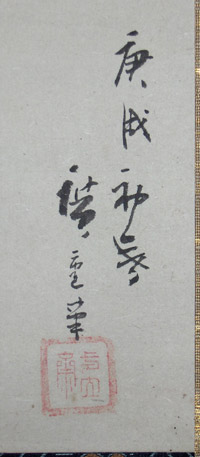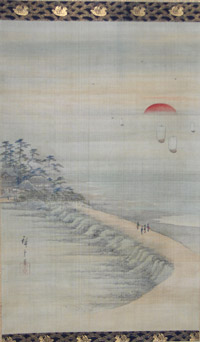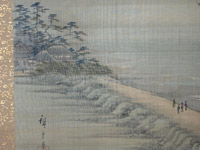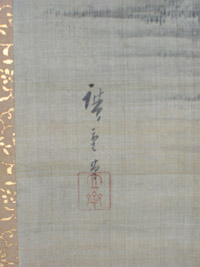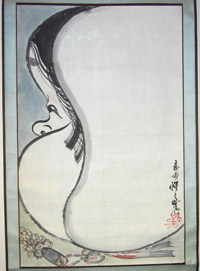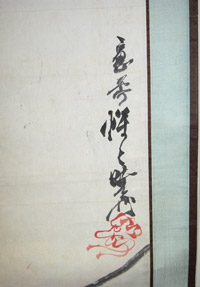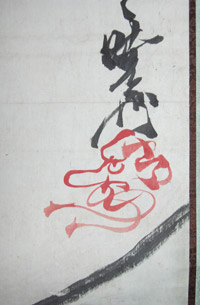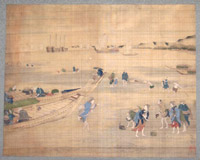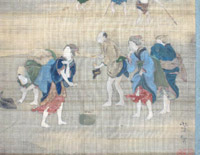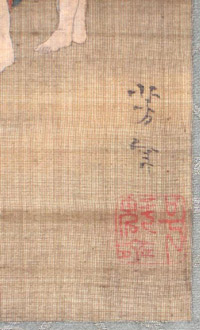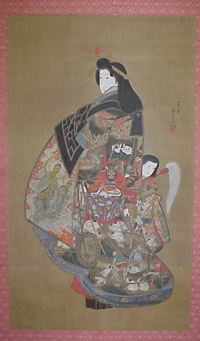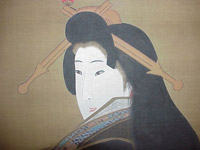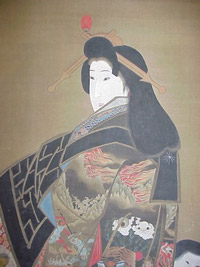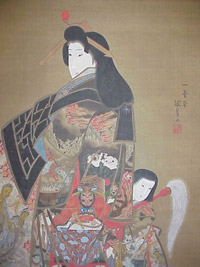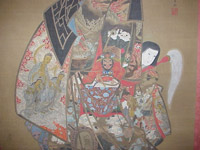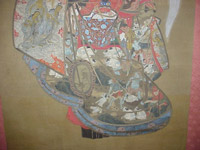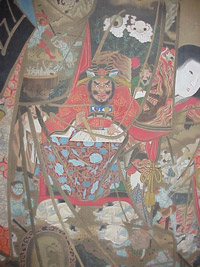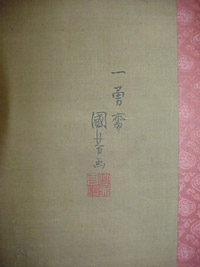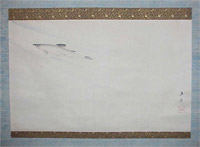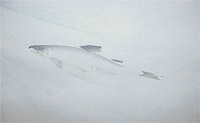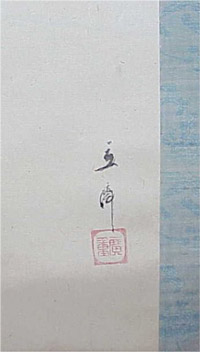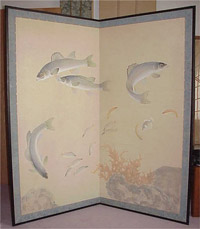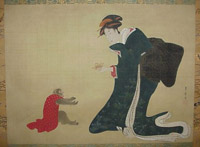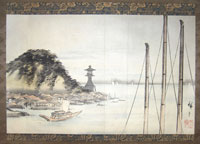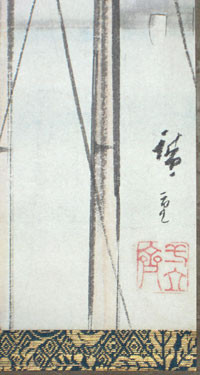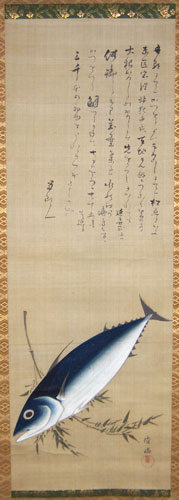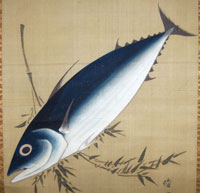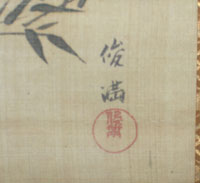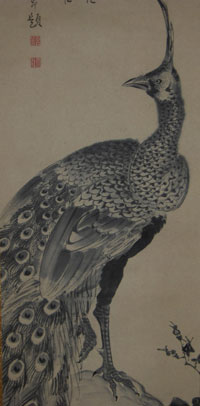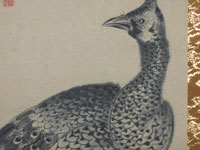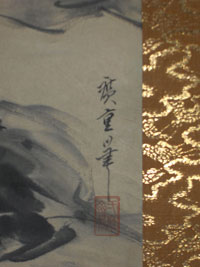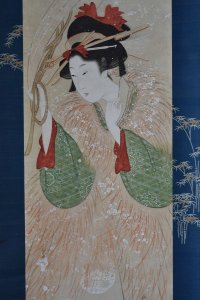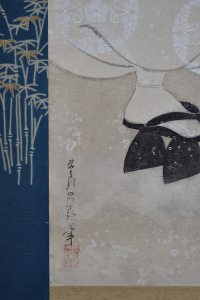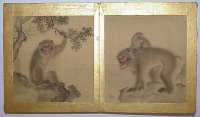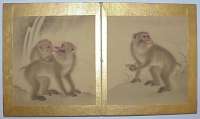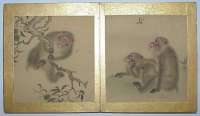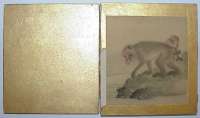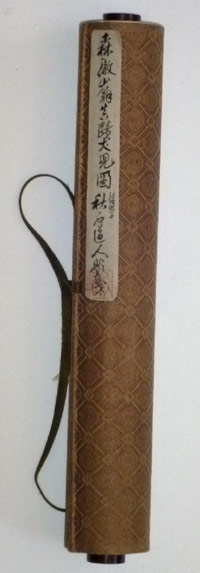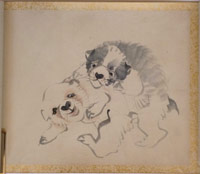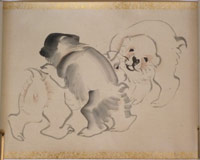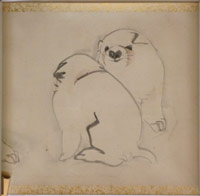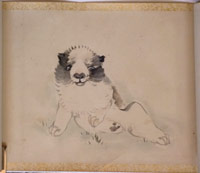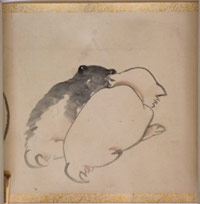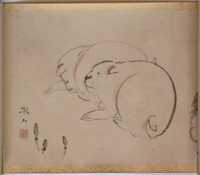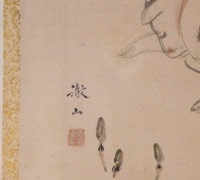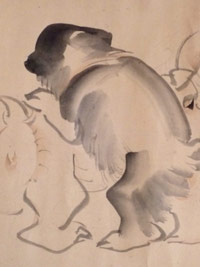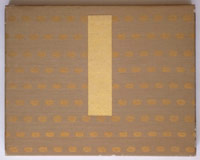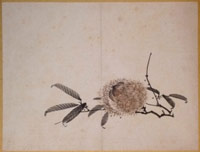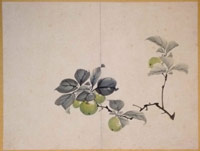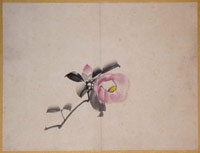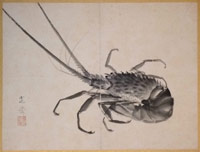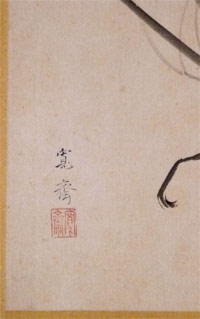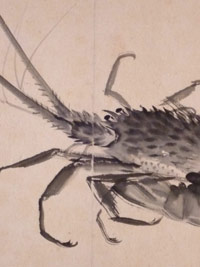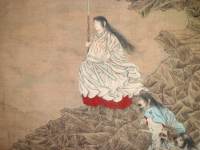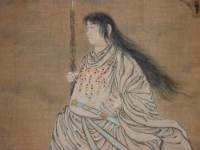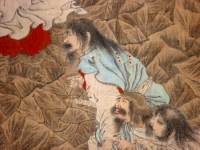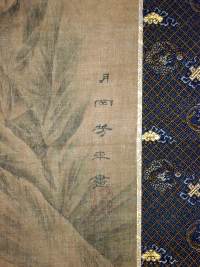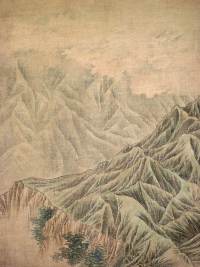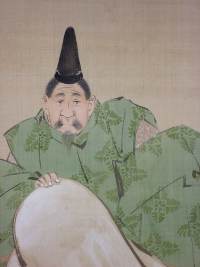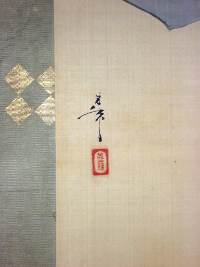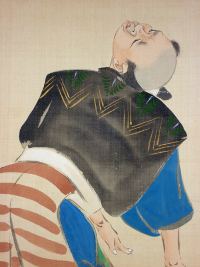/category/paintings/page/6/
Jokei RYUKOSAI (Fl. 1772-1816)
Click here to view image full size.
The most important Osaka artist in the last quarter of the 18th century. His prints are rare and, apart from being an influence on Shunei and possibly Sharaku, he spawned a line of fine pupils. His actor prints are trenchant and full of character. A delightful painting showing a geisha parading and looking askance at a client ( ? ). Full colour on silk, 27 x 13 in., 68 x 32 cms. Good condition. Old mount. Lacquer ends. Signed Ryukosai with kakihan.
Status: Sold
Utagawa KUNISADA (1786-1865)
Click here to view image full size.
An original painting on grey silk of an actor in a female role ( Segawa Kikunojo III ? ). Executed in fine detail – almost as a surimono with gold, silver and heightened gofun. Probably one of a set tipped into an album and commissioned by a wealthy patron of his favourite actors. Pin-ups of their day. 8.5 x 7 inches, 22 x 18 cms. Minor damage. Signed Ichiyosai Toyokuni hitsu, c. 1852.
Status: Sold
Ichiyusai KUNIYOSHI (1797-1861 )
Click here to view image full size.
An original and unrecorded painting of a young beauty reading a letter. She looks to be around 18 or 19 years old and this was most likely a commission from the girl’s family. ( The flower on her bodice is probably the family crest. ) Only 32 paintings are currently known by Kuniyoshi and this appears to date from c.1848-54. Sumi and full colour on paper. Minor loss of pigment, otherwise good condition. 100 x 30.5 cms; 39.5 x 12 inches ( image size ). New mount and box. Signed and sealed Ichiyusai Kuniyoshi. ( For other examples of these seals see Appendix 1, p. 261, Heroes & Ghosts, Robert Schaap, Hotei, 1998.)
Status: Sold
Ichiryusai HIROSHIGE (1797-1858)
Click here to view image full size.
A fine and important original painting by Hiroshige in the Shijo style, sumi and light colour on paper, showing a beauty beneath a tree. This manner of painting seems to have appealed to Hiroshige and some of his best work employs it. ( See Kobijutsu, Special Issue, Number 3, March 1983, Hiroshige, colour illustrations 5 and 18. ) Ex collection Takeoka Toyota with lid of box signed and dated ( 1920 ) by him. Extremely good condition with new mount and boxes ( but retaining original lid ). 112.4 x 51.6 cms; 44 x 20.25 inches. Signed, sealed and dated 3rd year Ka’ei era, 1850, Hiroshige hitsu with Ichiryusai seal.
Status: Sold
Ichiryusai HIROSHIGE (1797-1858)
Click here to view image full size.
An original painting; sumi and colour on silk showing sunrise on New Year’s day at Suzaki. This painting illustrated in The Memorial Exhibition, Hiroshige’s Two Hundred Anniversary, Dr Kobayashi Tadashi, 1996, no. 313. Image size 14.25 x 22 inches, 36 x 56 cms. Mounted as a scroll with box guaranteed by Dr Narazaki. Good condition. Signed Hiroshige ga with Ichiryusai seal.
Status: Sold
Kawanabe KYOSAI (1831-1889)
Click here to view image full size.
A large painting on silk, 54 x 34.5 inches ( 137 x 87.5 cms ) showing a side view of a huge Okame mask. Okame ( or Ofuku ) was the Goddess of Mirth, Ama no Uzume no Mikoto. She is known for helping Amaterasu out of the cave, into which she had retired, by performing a dance. At the bottom of the painting are the jingling bells used in her dance.
Minor wormage, otherwise good condition. Mounted with rollers and box. Signed oju Seisei Kyosai, “ By request, Seisei Kyosai “ with red kakihan of tengu mask
Status: Sold
Taiso YOSHITOSHI (1839-1892)
Click here to view image full size.
Sumi and colour on silk, 17 x 21.5 in., showing a view of a bay with boats moored in the background. In the foreground figures wading in shallow water looking at fish and getting ready for a picnic. Yoshitoshi paintings are rare and this is an unusual and early subject for him in the style of Kuniyoshi. Signature c 1864-6. The seal was used on various sets ( eg Ikkai zuihitsu and Keisei Suikoden ). Rare.
The painting has been professionally cleaned and mounted but still shows signs of browning. Loss of gofun. Signed Yoshitoshi with seal Go Yoshitoshi.
Status: Sold
Ichiyusai KUNIYOSHI (1797-1861)
Click here to view image full size.
An important unrecorded painting by Kuniyoshi. Sumi and colour on silk, 145 cms x 82cms. Shows the courtesan Jigoku Reigan of Takasu who was adopted and patronized by the priest Ikkyu. Her voluminous ceremonial attire is covered with designs of demons and the tortures of hell. This was a popular subject for Kuniyoshi and there are at least three self-portraits ( from the back ) showing him wearing a kimono adorned with these designs of hell ( see Heroes and Ghosts, Robert Schaap, 1998, figs 12, 13 and 14 ). Thirty one paintings are currently known by Kuniyoshi but this is probably his masterpiece. The painting has been professionally restored. Signed Ichiyusai Kuniyoshi ga
Status: Sold
Ichiryusai HIROSHIGE (1797-1858)
Click here to view image full size.
An original painting on paper of an ai or ayu, river trout, (Plecoglossus altivelis) swimming in a stream. Sumi and light colour, 11 x 18 inches: 28 x 46cms. Painting comes from the collection of the Hiroshige collector Mr Oda Kakukiti and is sold with box guaranteed by the museum curator (and teacher of Narazaki) Fugikaku Shizuya, dated Dec.25th, 1954. There is also a letter from him to Mr Kakukiti telling him he is happy to guarantee the painting. Rare: It is now extremely difficult to find genuine Hiroshige paintings. (See also Flora & Fauna on this website for the print version of this painting.)
Very good condition. Fully mounted with box. Signed Ichiryusai with seal.
Status: Sold
Ono BAKUFU (1888-1976)
Click here to view image full size.
An important two-fold screen in sumi and colour showing various Japanese fish and aquatic plants. Size of each panel 32 x 63 inches; 81 x 160 cms. Overall size double this. Bakufu is best known for his fish prints and paintings. Extremely decorative. Original mounting. Ex Spink & Sons.
Very good condition with only one small light stain. Signed Bakufu with seal.
Status: Sold
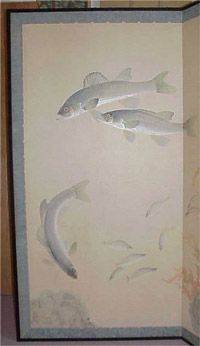
Click here to view image full size.

Click here to view image full size.
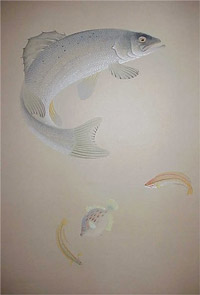
Click here to view image full size.
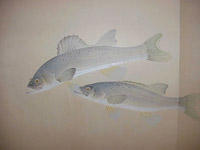
Click here to view image full size.
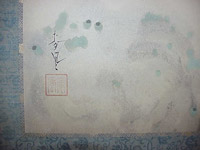
Click here to view image full size.
Ogata GEKKO (1859-1920)
Click here to view image full size.
A set of five tanzaku paintings on silk mounted onto card. Each painting is 14.25 x 2.25 inches; 36 x 5.75 cms.
Very good conditions. Each signed Gekko and sealed.
Status: Sold

Click here to view image full size.

Click here to view image full size.

Click here to view image full size.

Click here to view image full size.
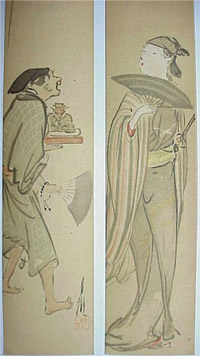
Click here to view image full size.
Utagawa TOYOHIRO (1773-1828)
Click here to view image full size.
A girl offering a fruit (?) to a pet monkey. Hanging scroll. Sumi and colour on silk; 52 x 38 cms. Signed Toyohiro ga, seal Ichiryusai.
Status: Sold

Click here to view image full size.
Ichiryusai HIROSHIGE (1797-1858)
Click here to view image full size.
An important original painting by Hiroshige showing the lighthouse at Tempozan ( Osaka ) and the Yodo River. Ships’ masts in the foreground. Tempozan ( Mount Tempo, Osaka – named after the era name ) was constructed in 1832 to prevent silting of the river mouth. Hiroshige paintings are now rare. Possibly originally one of a set from a makemono. Sumi and colour on paper. Image size: 32.4 x 51.4 cms; 12.75 x 20.25 inches. Mounted as a scroll with box.. Good condition. Signed Hiroshige ga with Ichiryusai seal.
Status: Sold
Kubo SHUNMAN (1757-1820)
Click here to view image full size.
An original painting of a bonito and a branch of bamboo. The bonito, called katsuo in Japan, was also called ocean bonito, strip-bellied bonito and striped tuna. It was, and is, highly regarded in Japan where it is smoked and dried to make katsuobushi, an important ingredient in making dashi ( Japanese fish stock ). The first bonito of the year were always highly anticipated. Shunman – an artist of great refinement – is famous for his exquisite surimono. Sumi and colour on silk with mica added to the eye and belly. Minor creasing and loss of gofun, otherwise good condition. Mounted with box. 90 x 31 cms; 35.5 x 12.25 inches ( image size ). Signed and sealed Shunman.
Status: Sold
Ichiryusai HIROSHIGE (1797-1858)
Click here to view image full size.
An important and rare original painting of a peacock ( Pavo cristatus ) perched on a rock with peony blossom ( Paeonia suffructiosa ). The regal peacock is usually shown with peonies, symbols of opulence and associated with summer. The subject and style borrows from the Chinese-derived Kano style, but with a spontaneous wet brush. The peony is the floral symbol of China and the peacock ( male peafowl ) was kept by the Chinese for centuries. It was a popular subject for Japanese artists of all schools and frequently used to demonstrate their dexterity, giving rise to often highly finished paintings. Hiroshige, as usual in his paintings, eschews this for a simpler approach. Hiroshige designed at least four prints of the same subject: An o-tanzaku published by Jakurindo, c. 1832; a chu-tanzaku with no publisher, c. 1832; a chu-tanzaku published by Marujin, c. early 1840s; and a kakemono-e published c. early 1840s. The style of signature on this painting dates it to c. 1832 – the best period for his kacho prints. Although I have had, and seen, a number of kacho hanshita-e, this is the first such painting I have catalogued. A Chinese-style poem top left. The painting is illustrated in the bicentennial exhibition of Hiroshige’s birth, The World of Hiroshige, 1996 – 1997, Mainichi Shimbunsha, no. 307; Ukiyo-e Painters and their Works, Volume 1, Yoshida Teruji, 1963, Ryokuen Shobo and was exhibited at the National Diet Library supervised by Dr Suzuki Shigezo, n.d. The inside of the box is guaranteed by Dr Narazaki Muneshige. Sumi on paper, mounted with box; image size 50 x 9.5 inches, 127 x 24 cms. Signed Hiroshige hitsu with Ichiryusai seal.
Status: Sold
Choensai EISHIN (Fl. 1795-1817)
Click here to view image full size.
An original painting by a rare pupil of Hosoda Eishi. He designed some fine bijin prints, including rare okubi-e. Shows a beauty in heavy snow with billowing trousers, a heavy straw cape and tall geta elevating her above the snow. She holds a wide-brimmed hat in her right hand to ward off the flakes of snow. Another painting by Eishin of a similar subject is illustrated in Klaus Brandt, Hosoda Eishi, 1977, 569, E22. Sumi and colour on paper with extensive splashed gofun; 10.2 x 39.5 in; 25.5 x 100.5 cms. An interesting aspect of the painting are the stencilled white roundels on the trousers. Newly remounted but retaining the fine old chu-mawashi and ichimonji futai parts of mount which are yuzen dyed fabric from Kyoto. Painted c. 1800.
Signed Toyogawa Eishin fude; seal unread. Some careful restoration at base, otherwise in very good condition. Rare.
Status: Sold
School of Mori SOSEN (c. early 19th century)
Click here to view image full size.
A group of seven small monkey paintings on silk, 11.75 x 11 cms. Of fine quality. Probably by a leading Sosen pupil. Mounted in a concertina album. Unsigned.
Status: Sold
Mori TETSUZAN (1775-1841)
Click here to view image full size.
A makimono with six paintings of Japanese Akita pups, sumi and light colour on paper. Painted area measures 73 x 11.5 in; 185.4 x 29.4 cms. Testsuzan, a highly talented but quirky artist with a penchant for animals, was adopted by his uncle, the celebrated painter Mori Sosen. One of Okyo’s ten best pupils, he moved to Edo from Kyoto bringing the Maruyama style to the Kanto region. In very good condition, remounted in recent years with fine outer silk cover and gold-flecked paper fore and aft. Rosewood rollers. Signed Tetsuzan with his seal at the end.
Status: Sold
Mori KANSAI (1814-1894)
Click here to view image full size.
A highly regarded artist who practised and taught the Shijo style in Kyoto. The pupil and adopted son of Mori Tetsuzan. A fine album ( 15 x 12 in; 38.2 x 30.5 cms ) of twelve Shijo drawings in sumi and light colour on paper. The album is beautifully presented with heavily gold-flecked paper throughout and silk brocade covers, the chitsu also covered in brocade. Some light foxing giving a wabi-sabi spirit to the work. Signed and sealed Kansai on last drawing.
Status: Sold
Tsukioka YOSHITOSHI (1839-1892)
Click here to view image full size.
An important two-fold screen, Yamatotakeruno mikoto at Mount Azuma. Yamatotakeru was the beautiful but fiery tempered third son of the Emperor Keikou (71B.C.-130 A.D.) He also had magical powers given to him by his aunt. His father decided to send him to the Eastern Provinces to subdue the barbarians. On the way aboard a boat, they encountered a violent storm. His wife, Ota-tachibana, threw herself in the sea to appease the Gods and drowned. Yamatotakeru continues his journey and reaches a rocky landscape. He gazes south east and in memory of his wife repeats three times “Azuma haya” (My wife, alas). Thus the mountain and area became known as Azuma. This is the scene Yoshitoshi depicts with Yamatotakeru surrounded by his entourage, gazing ahead, his long hair flowing. (He was able to pass as a woman in disguise, evidently.) Yoshitoshi had a jagged style of drawing and painting and the multitude of craggy outcrops allow him to fully indulge himself.
Full colour on silk, each panel 39.75 x 25 in; 101 x 63.5 cms. Extremely good condition. Signed Kinzaburo Yoshitoshi ga with blurred seal but reading Go Kaisai. Extremely rare.
Status: Sold
Tsukioka YOSHITOSHI (1839-1892)
Click here to view image full size.
An original painting, Hokosorori zu, showing Sorori Shinzaemon (at bottom) and Toyotomi Hideyoshi (1536-1598). Sororai was a sword sheath maker and otogishu to Hideyoshi (storyteller to attending provincial lords). “Sorori” means smooth and quiet, the name given to him because any sword fit his sheaths so perfectly. The episode depicted concerns Hideyoshi lamenting the fact that his face looked like a monkey. Sorori cleverly tells him that he is lucky that monkeys respect him to such a degree that they try to look like him. Hideyoshi enjoys the reply and inquires what he would like as a reward. Sorori asks him for a grain of rice to be doubled-up every day for one hundred days. After this period Hideyoshi realises his mistake and demands that Sorori change the reward.
Full colour on silk, image size 34.75 x 11.5 in; 88.2 x 29.2 cms. In very good condition. Beautiful mount. Signed Yoshitoshi with Taiso seal.
Status: Sold
